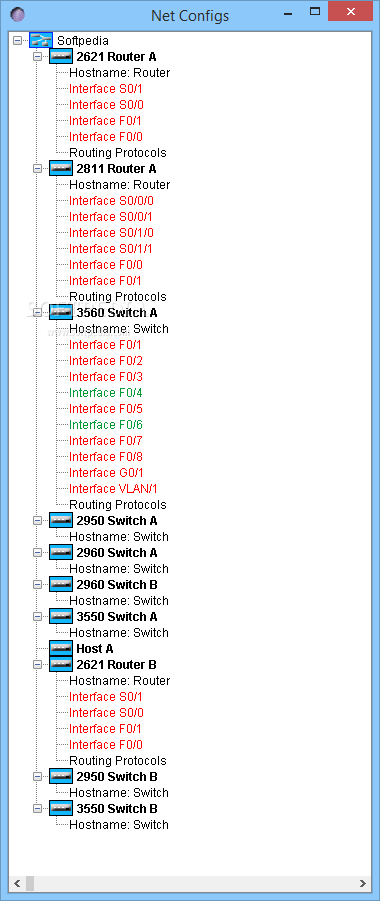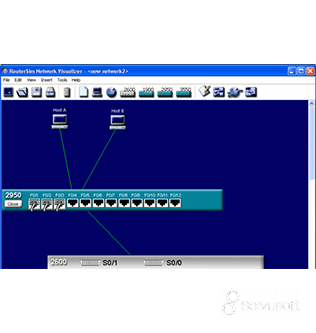
- #CCNA NETWORK VISUALIZER CONFIGURE ROUTER IP SERIAL#
- #CCNA NETWORK VISUALIZER CONFIGURE ROUTER IP FULL#
- #CCNA NETWORK VISUALIZER CONFIGURE ROUTER IP SIMULATOR#
The problem is that a) the tutorial does not keep track of what you typed, so you have to stop typing and use the mouse to scroll down to see the next screen after every third command, and b) when you do scroll down, you then have to go back up and click in the router screen again before you can type.
#CCNA NETWORK VISUALIZER CONFIGURE ROUTER IP SIMULATOR#
When you go into lab mode, the screen splits into two sections a step-by-step tutorial on the bottom and the router simulator up top (or in a popup box). A well-designed popup glossary helps ease the pain a bit.Īnother problem is that the lab interface is a bit off. You can work through this study guide manually, but if this is your only resource you'll be in for some work.
#CCNA NETWORK VISUALIZER CONFIGURE ROUTER IP FULL#
For one thing, the labs are short on explanation it's explained that they're supposed to be a companion to Sybex's bestselling (and well-written) CCNA Study Guide, but many times they consist of extensive lists full of arcane commands that you type in blindly, without any further explanation. While these are thorough and will do the job, some minor but extremely irritating glitches keep them from being top quality. If you find setting up a network intimidating, you can also use the labs-tutorials that will walk you through setting your system up. (It's probably best to stick to the suggested IP addresses, anyway.) But if there's a genuine problem and you're confused as to why your tweaks have caused failure, Sybex has provided a "network visualizer" to show you your network, and also adds a "net detective" that ferrets out simple problems like shut interfaces and absent protocols. However, it's not perfect-when I inputted some different IP addresses and static routes and then tried to ping legitimate servers, I encountered some difficulties in connecting when it should have gone off without a hitch.

Generally, changing things works pretty much as it would in real life, with valid configurations resulting in a happily chugging network, and invalid configurations causing an Addams Family-style train wreck. (Warning: On our test machines, the installation had a slight glitch although a shortcut was placed on the desktop, nothing was put in the start menu.) You can choose your own IP addresses and set the routers as you choose. When you start up the program, you'll need to configure the routers from scratch. This isn't really a problem for test takers, though, and it won't keep you from getting a passing grade.
#CCNA NETWORK VISUALIZER CONFIGURE ROUTER IP SERIAL#
Type in "interface serial 0" and that will work fine, for example, but typing "interface tokenring 0" will get you an "Invalid input" error. However, be warned that all the commands aren't supported in every iteration-particularly when using unabbreviated commands, you should expect to run into occasional misfires. A couple of hours spent tinkering around in the Virtual Laboratory is worth weeks of book memorizing the commands come to mind a lot more quickly when you've "seen" them in action, and the responses are generally what you'd expect from a real router. A large number of commands are supported, with the appropriate options enabled-it's not enough to quite get you through the next level of CCDP exams, but all of the major commands you need to know for the CCNA are feigned properly. The Cisco simulations are well done and appear to be thoroughly customizable. It's not a perfect simulation, but at only $99.99 retail, it's thousands of dollars cheaper than buying the actual equipment for a test lab-and what's presented here is more than enough to get you the experience you need to pass the CCNA. The CCNA Virtual Lab e-trainer puts you in charge of a simulated network with three Cisco routers (two attached to token rings), two host computers, a Catalyst 1900 switch, and a couple of WAN links. "synopsis" may belong to another edition of this title. * Secondary network addresses and frame types * Backing up, upgrading or restoring your router IOS

* Setting passwords, hostname, IP address, and clock rate

* Starting and saving router configurations Simulating a network environment consisting of three routers, one switch, and one host, this program provides hands-on practice for the following topics and more:

You can practice with this, "equipment" on your own, use it in conjunction with suggested labs that cover CCNA exam objectives, or even design custom labs. The CCNA Virtual Lab gives you everything you need to tackle Cisco's challenging simulation format questions. Until now, this has required access to expensive network equipment-not to mention the freedom to experiment with it. If you're serious about passing the new CCNA exam (#640-607), you need hands-on experience with routers and switches.


 0 kommentar(er)
0 kommentar(er)
